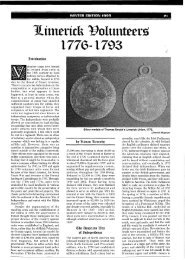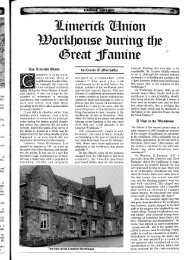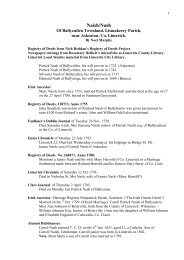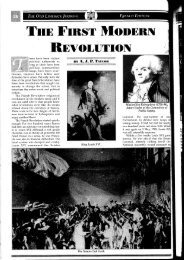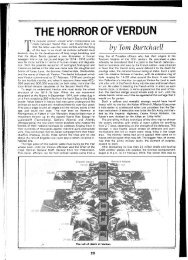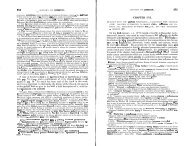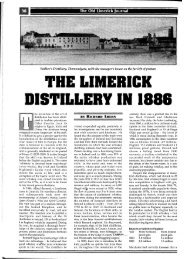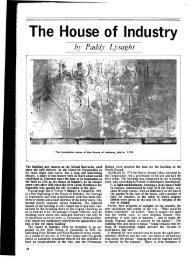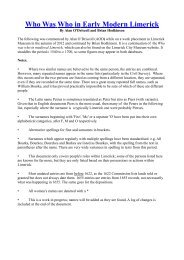The Limerick City Militia 1798 by Kieran Kennedy
The Limerick City Militia 1798 by Kieran Kennedy
The Limerick City Militia 1798 by Kieran Kennedy
You also want an ePaper? Increase the reach of your titles
YUMPU automatically turns print PDFs into web optimized ePapers that Google loves.
Statue to General Gough in the Phoenix Park, Dublin, c.1900.<br />
<strong>Limerick</strong> Museum.<br />
also returned loaded with great coats,<br />
blankets, shoes, pikes &c.<br />
"Nothing could equal the ardour of our<br />
<strong>Limerick</strong> lads; they would have burned<br />
down every house, and killed every man<br />
they met, had I not restrained them; they<br />
are the most desperate fellows I believe<br />
on earth, and I am sure loyal; not a<br />
man received the slightest wound."<br />
<strong>The</strong> following morning Gough received a<br />
letter from General Champaigne at<br />
Dublin:<br />
"Sir, I am this moment favoured with<br />
your report of the affair of Tuesday<br />
morning, for which I return you many<br />
thanks. I have not only acquainted the<br />
Commander-in-Chief, but the Lord<br />
Lieutenant, of your conduct and success,<br />
of which I was an eye-witness, and your<br />
not having lost a man in the action was<br />
a proof that your disposition of action<br />
was not only planned with judgement,<br />
but conducted with spirit."<br />
A letter from an officer of the <strong>City</strong> <strong>Militia</strong><br />
stationed at Edenderry and dated 1 July<br />
<strong>1798</strong> reads in part:<br />
7 have jmt returned in after giving the<br />
rebels a good drubbing. I marched<br />
against 300 of them with 60 men<br />
(infantry); I sent some cavalry to<br />
surround the hill where they were posted,<br />
but the moment I appeared they Bed,<br />
keeping up hot fire on us in every<br />
direction; However, we routed and drove<br />
them to the cavalry who gave them a<br />
warm reception. I am certain upwards<br />
of 300 of them were killed. <strong>The</strong>re was a<br />
Priest and a Captain Casey at their<br />
head, who were both killed; the latter<br />
being this townsman we brought him<br />
back where he now remains hanging."6<br />
On the arrival of the French under<br />
General Humbert at Killala Bay on 22<br />
August, the Regiment, under the<br />
command of Col. Charles Vereker, was<br />
ordered to Sligo. <strong>The</strong>y had reached<br />
Carrick-on-Shannon when the defeat of<br />
government forces at Castlebar on the<br />
27th August occurred, and carried on to<br />
Sligo.<br />
<strong>The</strong> small French expeditionary force<br />
under General Joseph Humbert was<br />
primarily an infantry force composed of<br />
the 70th Demi-Brigade, but did include<br />
artillerymen and some cavalry from the<br />
3rd Hussars, the whole amounting to<br />
about 1,000 men After taking Castlebar,<br />
Humbert, on the advice of his Irish allies,<br />
moved northwards, Sligo town being the<br />
next objective, where Col. Vereker's 600<br />
men of the <strong>Limerick</strong> <strong>City</strong> <strong>Militia</strong> was the<br />
principal garrison. Vereker was then 30<br />
years of age. He was born in 1768 in the<br />
old mayoralty house in <strong>Limerick</strong>, his<br />
father being mayor at the time. In 1782, at<br />
the age of 14, he was entered as a<br />
midshipman in HMS Alexander, a ship of<br />
74 guns, and saw service at Gibraltar, then<br />
under blockade <strong>by</strong> a combined French<br />
and Spanish fleet. <strong>The</strong> Alexander was one<br />
of three British ships laden with<br />
provisions that managed to pass the<br />
blockade, and Vereker was reported as<br />
being the first to leap ashore. On putting<br />
to sea again, his courage in the action<br />
between the two fleets earned him the<br />
public acknowledgement of the cm-<br />
mander, Lord Longford. With the peace of<br />
November 1782, the size of the navy was<br />
reduced, and Vereker retired from the<br />
service and took a commission in the 1st<br />
Royals, which regiment he left on coming<br />
of age in 1789. He was promoted to<br />
Colonel of the <strong>City</strong> <strong>Militia</strong> in 1797.8<br />
At about 9 o'clock on the morning of<br />
the 5th September, Captain O'Hara of the<br />
Liney yeoman cavalry, who commanded<br />
Vereker's advance piquet at Tubbercurry,<br />
reported to him that he had been driiren<br />
back <strong>by</strong> an advance force of the Fren~h<br />
after a short skirmish in which he had cine<br />
man killed and another wounded. Vereker<br />
considered that it would be better to<br />
attack rather than wait to be attacked, and<br />
marched out of Sligo with 250 <strong>Limerick</strong><br />
<strong>City</strong> <strong>Militia</strong>, two curricle guns, 30 yeomen<br />
infantry and a troop of the 24th Regiment<br />
of Light Dragoons towards Collooney,<br />
about five miles from Sligo.9<br />
Two rivers, the Owenmore and<br />
Owenbeg, join a short distance from<br />
Collooney and at the village itself flow into<br />
the River Arrow. <strong>The</strong>se rivers, over a<br />
rocky bed, plunge over ledges forming<br />
numerous rapids. A long range of well-<br />
wooded hills up to 900ft. high extends<br />
from close to the river at right angles<br />
eastwards. <strong>The</strong> road from Collooney to<br />
Sligo passes <strong>by</strong> the side of the river for<br />
about a mile and a half, turning around the<br />
extremity of the ridge at Carricknagat, and<br />
then over open level ground to Sligo.<br />
General Humbert's force at Collooney<br />
consisted of nearly 3,000 men, 1,000<br />
French, 250 men of the Longford and<br />
Kerry <strong>Militia</strong>s who had changed sides, and<br />
about 1,300 Irish insurgents of dubious<br />
quality. <strong>The</strong> basic weapon of the<br />
insurgents was the pike, but some had<br />
captured swords, pistols and muskets, and<br />
indeed some were actually supplied <strong>by</strong> the<br />
French, and they also had nine pieces of<br />
cannon.1° When General Humbert's force<br />
arrived at Collooney on 5th September, its<br />
intention was to rest, as they had been<br />
harried constantly <strong>by</strong> crown forces for<br />
eight days since they left Castlebar. One<br />
French eyewitness account says:<br />
"having arrived there, the men had just<br />
piled arms and dispersed, and were busy<br />
procuring provisions and firewood to<br />
make a meal, when suddenly the sound<br />
of the cannon and the shot that were<br />
flying into their encampment warned<br />
them of the enemy's approach. <strong>The</strong><br />
soldiers had only time to abandon, some<br />
their loads of firewood, others their<br />
provisions such as potatoes &c, and to<br />
hasten to get under<br />
Col. Vereker picked his position well at<br />
Carricknagat, his left protected <strong>by</strong> the<br />
river, his right resting on the hill, with his<br />
guns placed on the high road. His men<br />
were so disposed as to make the most of<br />
the little force as possible and at the same<br />
time conceal the smallness of their<br />
number. An advance guard of 100<br />
<strong>Limerick</strong> <strong>City</strong> <strong>Militia</strong> under Captain<br />
Vincent was sent out to watch the rebel<br />
movements, while Col. Vereker moved on<br />
with 20 of the 24th Dragoons, 30 Yeomen<br />
Cavalry, 250 <strong>Limerick</strong> <strong>City</strong> <strong>Militia</strong>, 20



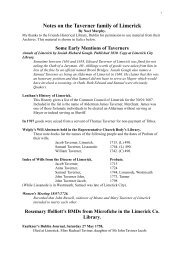
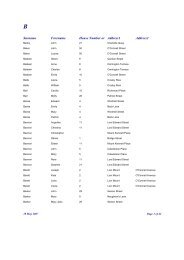
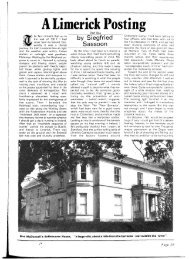
![The Galbally farmer [poem] by Darby Ryan - Limerick City Council](https://img.yumpu.com/24792577/1/190x260/the-galbally-farmer-poem-by-darby-ryan-limerick-city-council.jpg?quality=85)
